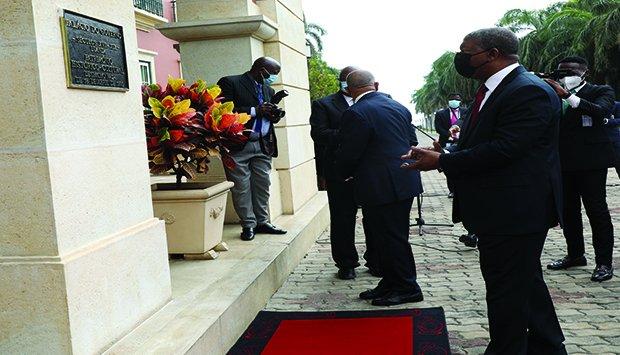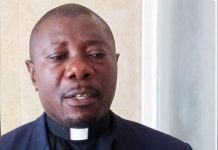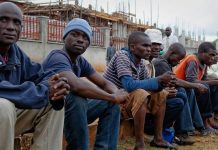Africa-Press – Angola. The President of the Republic opened the second phase of the campaign to identify and classify national heritage this Monday (18) in Luanda with the unveiling of the plaque that identifies the Government Palace (popularly called the Presidential Palace) as heritage cultural history.
João Lourenço unveiled the plaque, which is at the main entrance of the building, in the morning, in a ceremony that was attended by the Vice-President of the Republic, Bornito de Sousa, the ministers of State and the head of the Military House of the President of the Republic, Francisco Furtado, for Economic Coordination, Manuel Nunes Júnior, for the Social Area, Carolina Cerqueira, for the Ministers of Territory Administration, Marcy Lopes, for Culture, Tourism and Environment, Filipe Zau, for Education, Luísa Grilo, for the governor of Luanda , Ana Paula de Carvalho, and several senior officials in her Cabinet. At the end of the event, the President of the Republic did not speak to the press.
According to data from the Ministry of Culture, Tourism and Environment, the first phase of the heritage identification and classification campaign began in the 1990s and ended in 2020. The Minister of Culture, Tourism and Environment said that they had already been classified, so far , 321 sites, with the Government Palace being the most representative.
“We will continue to develop these activities. There are more buildings to be classified and identified”, stressed Filipe Zau, for whom this act symbolizes the sense of belonging, related to the national heritage historical memory, which can serve, in the future, as a place of study for the new generations.
Of the various sites already classified, the minister highlighted, for example, the Evangelical Mission of Mouse, in the province of Bié, the Palácio do Comércio, in Benguela, the Cine Estúdio and the nine rock art stations of Caramulo, in Namibe, the Evangelical Mission of Dondo, in Cuanza-Norte, the Igreja Matriz do Waku-Kungo, in Cuanza-Sul, and the Maria da Madalena United Methodist Church, in Luanda.
He referred that, in the field of heritage education, the Ministry of Culture, Tourism and Environment has sought to commit itself to promoting national, movable and immaterial, material and immaterial cultural heritage, through the motto “Knowing to Preserve”.
He added that this act is being carried out not only through work activities and the exercise of citizenship, but also through culture, with the defense of the national heritage included in the aim of education for endogenous and sustainable development.
“Recovering and relaunching heritage in places such as Massangano, Dondo, Cambambe, Pungo Andongo, Luanda, Benguela, Ambriz, Catumbela, Namibe and so many other places in our country, associated with the promotion of tourist and artistic activity are concerns of the Executive”, assured.
Historical data of the Government Palace
The Government Palace was built in 1607/1611, initially to serve the Luanda Chamber. Between 1621 and 1630, it was adapted to function as the Governor-General’s Palace, under the colonial administration of Fernão de Sousa. In 1761, at the time of the Marquês de Pombal government, the building was almost completely demolished and rebuilt in the Pombaline style. It remained so until the 40s of the 20th century, when it received a renovation led by the architect Fernando Batalha. It was expanded, modernized and unified with the Episcopal Palace and the Casa da Junta Real. Date of this remodeling the current classicizing facade.
After Angola’s independence, the palace, which until then had been the seat of the colonial government, became the official residence of the President of Angola. It was classified as Cultural Heritage by the then Ministry of Culture, through Order No. 24, of 18 April 1995, and the act performed yesterday by the President of the Republic served only for the unveiling of the plaque that marks this fact.
The palace is located close to the Cidade Alta Gardens. It is flanked by the Episcopal Palace and the Church of Jesus. The Ministry of Justice building is also located in Largo do Palácio, immediately north of the Colégio do Santíssimo Nome de Jesus and the Luanda Seminary. When presenting, on the occasion, the historical review of the building, the deputy director general of the National Institute of Cultural Heritage, Emanuel Caboco, said that the works had started between 1607 and 1611, in a place known, at the time, as Largo da Feira, one of the main slave markets at the time, in Luanda, which later became known as Largo do Palácio and, more recently, Praça do Povo.
Emanuel Caboco stressed that the Palace was the first seat of the Government of Independent Angola, having, since 1979, housed the remains of the first President of Angola, António Agostinho Neto.
“For decades, it was known as the People’s Palace and hosted all the tributes paid to President António Agostinho Neto until roughly 1991, when the remains were definitively deposited in the Dr. António Agostinho Neto Memorial”, he stressed.
Emanuel Caboco also said that, between the late 1990s and early 2000s, the building once again received intervention and monitoring by the Office of Special Works, within the framework of the creation of the new administrative political centre, returning shortly afterwards to its function. of the seat of the Government of Angola.
The deputy director general of the National Institute of Cultural Heritage said that the sum of interventions carried out over three centuries in the Palace, “if not four”, resulted in what was called “a perfect” symbiosis of styles, from Pombaline to neo-classical and which make it, not only one of “the most beautiful buildings” in the historic area of Luanda, an important repertoire of facts linked to national historiography, particularly the recent history of the country.
For More News And Analysis About Angola Follow Africa-Press






